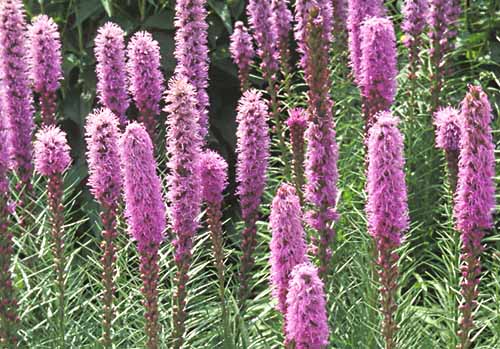A really lovely native perennial wildflower with tall stiff stems of bright purple flowers. It needs full sun and prefers poor soil. Once established needs virtually no maintenance or care. Fairly drought tolerant for short periods but does better with some weekly watering if there is no rain. It makes an excellent cut flower and its nectar-rich flowers are a favorite with butterflies and hummingbirds. Will flower in second year from seed, after which clumps will increase in size yearly.
Description of Blazing Star or Gayfeather (Liatris spicata).
Perennial hardy to zone 3. Begins as a small clump of narrow grass like leaves up to 12" (30cm) long. Leaves are medium green in color and curl over forming a small basal tuft. From this in early to mid summer one or more tall stalks arise. Stems have lower leaves that decrease in size as they ascend, the top 6-12" (15-30cm) or more of the stem is flowers. Each small flower has long fluffy petals which gives rise to its name gayfeather. The spikes are stiff and upright and unusually for plants flower from the top of the stem downwards. Flower stalks are thick and unbranched and stay in bloom for a month or more. Plant grows from a small corm which over winters in the ground easily coming back year after year. From seed plants will flower in their second year.
Growing Blazing Star or Gayfeather (Liatris spicata) from seed.
Germination can take anywhere from 20 to 45 days. Seeds require a period of cold to germinate (called stratification) all our seeds have been cold stratified. Seeds can be sown directly into the garden in early spring however due to the long germination period weeds can easily take over the bed before the plants have the opportunity to grow. Weeding can be difficult since seedlings look like grass. Seeding indoors is suggested to retain control of the plants growth. Plant seeds as per our General Growing Instructions for medium seeds, barely cover the seeds. Transplant to their own pots when large enough to handle. Plant out in later spring or summer, ensure plants are hardened off first and plant out on a cloudy day when rain is due to ensure that the plants get the best start in their new home. Space about 15" (38cm) apart. Once the corms have developed they will produce new small corms each year and the plant will grow into a small then large clump of flowers. It is recommended that clumps be divided every 4-5 years. Plants grown from seed will not flower until their second year.
Location and Care of Blazing Star or Gayfeather (Liatris spicata).
Blazing stars need full sun to flower well but they can tolerate most soil types as long as they are well drained. It's a tough native perennial of the prairies so its ideal habitat is full hot sun on well drained soil with lots of air circulation. They will not grow in wet or waterlogged soils. They also cannot tolerate soils that are wet in winter as it will rot out the corms. Plant do best with at least a weekly watering - if there is not rain - to perform at their best. Once established they are fairly drought tolerant but will not produce good flowers and leaves if planted in a location that gets very little water. They can however withstand occasional droughts with no problems.It prefers a poorer soil and will tend to become lush and develop weak stems if given too much rich loam. A small amount of mulch around the plants either in winter or early spring should suffice, don't overdo it. It is not necessary to feed the plants in most cases.
Blazing stars is a great plant for borders and sunny areas were color is needed in summer. The compact nature of the plant makes it ideal for small compact areas or corners where color is needed but there is little space. It is a favorite of both butterflies and hummingbirds so planting near a deck or window gives the added attraction of wildlife viewing.
Pests and Diseases of Blazing Star or Gayfeather (Liatris spicata).
Liatris may develop mildew if planted where there is insufficient sunlight and air circulation so ensure the location allows for plenty of room and sunshine.
Medical Uses of Blazing Star or Gayfeather (Liatris spicata).
Both the leaves and the roots can be used. Liatris has long been used to treat sore throats, and it is reported to be extremely effective in treating gonorrhea. The leaves are lightly aromatic due to a compound called Coumarin which has diuretic properties and is valuable in treating Brights disease. The substance is also reported to have a anti clotting effect on the blood and can prevent clotting when there is a cut.
Other uses of Blazing Star or Gayfeather (Liatris spicata).
The aromatic leaves and roots can be added to pot-pourri as well as various herbal insect repellants. It is also used to flavor some types of tobacco and bags of the dried leaves in the closet are said to repel moths.
Other names
Snakeroot, Button, Gay Feather. Devil's Bite. Colic Root.








